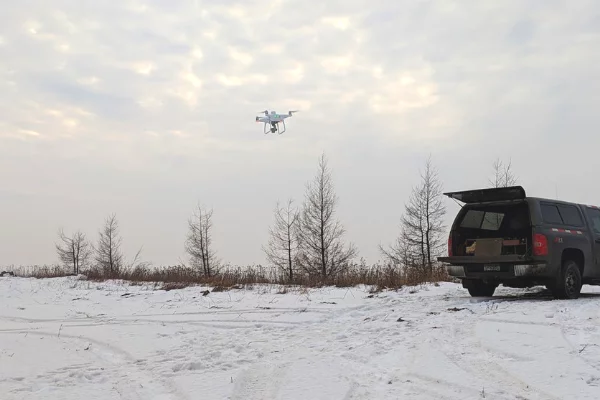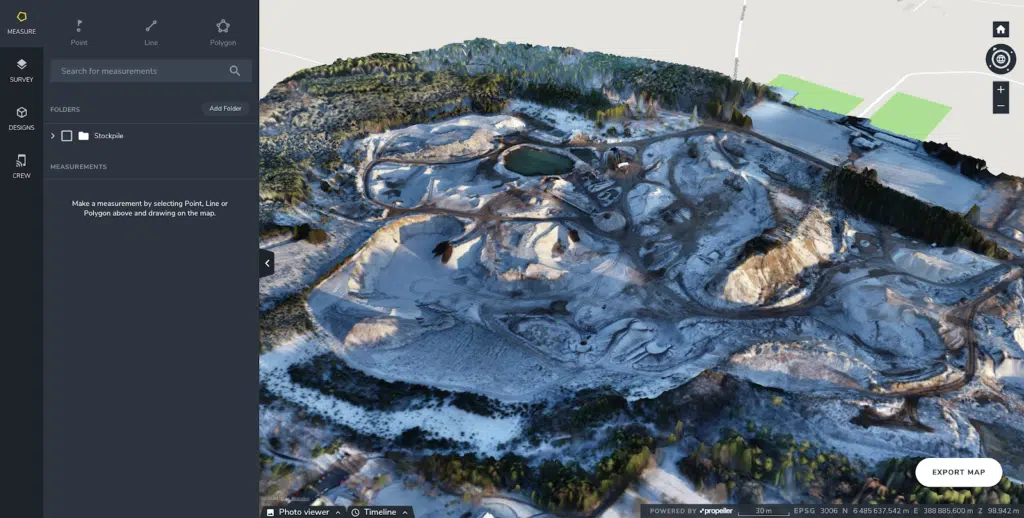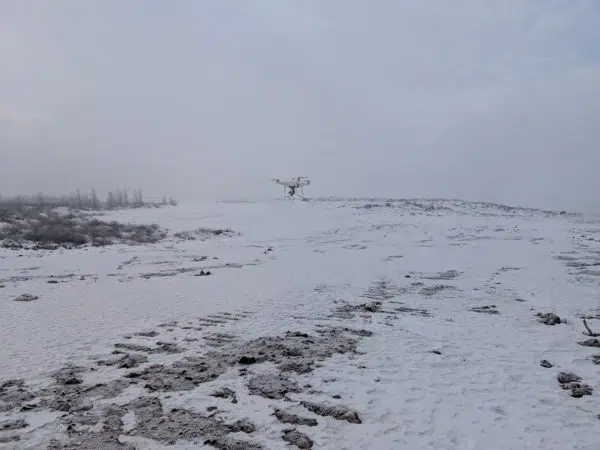The Pocket Guide to Drone Flying in Winter
As weather conditions change with the approach of winter, new commercial drone pilots ask us questions like: “Can I fly my drone in cold temperatures or fly my drone in snow?” or “Will condensation affect my drone’s camera operations?”
Although it’s not advisable to fly in extreme winter weather conditions, we understand many drone pilots won’t run inside at the first sight of snow. When you need to collect critical information, like topographical surveys, waiting for a more placid day might not be an option.

To help you overcome the elements and keep your drone flying in winter, we’ve put together some best practices and tried-and-true advice.
- Keeping an eye on your battery life
- Compensating for darker skies
- Flying in windy, blustery weather conditions
- Coping with flight performance issues caused condensation
- Can you fly a drone in snow?
- Can you fly a drone in freezing weather?
- Cold weather drones
- Don’t just prep your drone for cold weather conditions—prep yourself!
- Plan your mission before flying your drone
Keeping an eye on your battery life
The greatest inconvenience to flying a drone in winter is the cold temperatures’ effect on your drone’s lithium polymer (LiPo) batteries.
Cold temperatures reduce chemical activity in Lipo batteries used in drones, such DJI’s Phantom 4 RTK (P4RTK). This causes your drone to lose power faster—50% faster in some cases. In extreme cold conditions, your drone might even shut down mid-flight.
Here’s what to know if you plan on flying in cold weather:
- Turn your drone on and let it warm up for a couple of minutes before launching.
- Begin with fully-charged batteries and check your battery life more than usual mid-flight. If you track the rate your drone is using power, you can plan when it’s time to bring the drone back to home base, averting a crash.
- Bring extra, fully charged, LiPo batteries if you plan to fly for a while. Taking extra time to swap out a drone battery is preferable to your drone losing power and crashing.
- Consider where you store your drone and LiPo batteries when you’re not flying. If the space is significantly cooler during cold weather, move them somewhere warmer.
- Keep your extra batteries inside your vehicle while you’re flying. It’s not just your drone that you have to worry about. The batteries in your controller will also use power faster in cold weather. Don’t leave your controller exposed to extreme cold more than necessary.
- If you’re working in especially frigid weather conditions, consider investing in a battery warmer.
Compensating for darker skies
Snow and overcast skies can negatively affect your drone camera’s settings, resulting in underexposed photos. You can counteract this by decreasing your shutter speed and adjusting the white balance.

Most drones, like the P4RTK, include white balance settings like “sunny” and “cloudy.” Try manually adjusting your camera settings before flying your drone if you’re having issues with the auto-white balance settings.
Here are a few other tips to keep in mind:
- Monitor your ISO as it gets darker. If your drone’s camera increases ISO above the recommended range (100-400 for the P4RTK, for instance) there may be too much grain or noise in your photos, making them unusable.
- Always aim to fly when the sun is directly overhead (except when flying your drone over reflective surfaces), as this will reduce the chance that shadows distort your images.
- To decrease the chance of motion blur, you might want to decrease your drone’s speed by 1-2 mph. Blur above 20mm is considered problematic.
- FAA regulations prohibit flying a drone before sunrise and after sunset. Monitor changes to daylight throughout the season and adjust your flight schedule accordingly.
Flying in windy, blustery weather conditions
Unless you’re a seasoned drone pilot and comfortable flying manually, you should not fly your drone when the surface wind speed is above 15 mph. Flying in anything stronger than that jeopardizes a safe flight, and you risk a crash. In the event of a crash, you may have to wait weeks or even months before you can procure a replacement drone.
In addition to the cold temperatures, strong winds will negatively affect battery life, sacrificing flight performance. Your drone will have to work harder to fly against the wind to overcome the turbulence. So, even if your drone is able to handle the high winds, you still risk a crash if you let your LiPo battery levels drop too low.

You can check weather forecasts at UAV Forecast, which allows you to calculate wind speeds at the altitude you’ll be flying your drone. UAV Forecast also has a mobile app for Android and iOS you can use on your mobile device when in the field.
If you must fly in windy conditions, follow this advice to ensure a safe flight:
- Fly perpendicular to the wind. If you can’t, fly upwind first and then downwind, back toward you.
- Be more attentive to your drone than normal, especially when flying with the wind. If you notice that it’s having a hard time staying level, bring it home immediately.
- Be careful during your takeoffs and landings. Though winds are more powerful the higher the altitude, your drone can veer off course more easily when it’s just getting off the ground or decelerating during landing.
Coping with flight performance issues caused condensation
In many areas, cold weather also means increased condensation. Too much moisture in the air can cause a number of issues with your drone’s ability to operate properly. With enough exposure, moisture can ruin the drone’s propeller motors, camera, and internal systems. If you’re using a GPS-enabled drone, condensation can also disrupt those signals, distorting your geotags.
Here are a few things to keep in mind:
- Although it may seem obvious that you should skip flying in the rainy or snowy weather conditions, flying a drone in fog is not a good idea, either. Fog can trigger the drone’s obstacle avoidance sensors, making it think something is in front of it and thereby stopping the flight mid-mission.
- Choose a drone with high-visibility lights on the body of the craft, so you can spot it in the sky in extreme weather conditions.
- Not only do you need to account for the moisture in the air, you should avoid contact with snow on the ground, too, as moisture can damage your drone’s motors. Use a pad or another elevated surface for launching and landing your drone.
Can you fly a drone in snow?
You should skip flying in rainy or snowy weather conditions, which can hamper your drone’s ability to operate properly. Be sure to avoid contact with snow on the ground, too, as moisture can damage your drone’s motors. Use a pad or another elevated surface for launching and landing your drone after a snowfall.
Snowfall presents a unique hurdle when capturing topography with photogrammetric drone surveys. Photogrammetry works on the principle of using 2D images from different angles to reconstruct real-world features in 3D. To be able to identify those features, you need to be able to tell one photo from another.

Fresh, untouched snowfall makes this extremely difficult. If there are enough disruptions to the snow on the ground—such as tire marks from vehicles and heavy construction machinery—you may be able to generate a usable survey, but it’s not guaranteed.
So, if you decide to fly your drone after a snowfall, make sure there are enough breaks and gaps in the blanket of snow for your drone to distinguish features on the ground. Compare your measurements to a survey you took during clear conditions. Are the discrepancies small enough to justify flying your drone with snow on the ground again?
Can you fly a drone in freezing weather?
Yes, you can fly a drone in freezing weather but as you can probably tell by now it does make things a lot more difficult than they would be with warmer weather. If you absolutely must fly a drone in freezing weather conditions we recommend that your drone pilot have extensive experience and that you optimize your hardware to best deal with the colder conditions.
When not taking these extra steps to ensure safety, flying a drone in below freezing weather can easily result in broken hardware and significant project delays.
Cold weather drones
As we have mentioned, when the temperature decreases, the performance of your drone’s batteries deteriorates. This situation will most likely occur when weather conditions approach or drop below 0 °C or 32 °F. Aside from battery life, here are other specifications you should review for your drone to determine if yours is suitable for flying in cold weather:
- Maximum wind speed your drone can fly
- Range of optimal operating temperatures
- Maximum flight altitude
To combat moisture and freezing precipitation, ensure your drone has an IP rating of at least IP43 to fly during winter.
DJI’s Matrice 300 (M300) is a Propeller-recommended drone and is suitable for flying large-scale and complex worksites in cold, winter weather. With its long battery life, the M300 can handle a maximum flight time of up to 55 minutes, depending on payload, and a flight speed of 23 m/s (51.5 mph). It can withstand tough weather conditions, and can operate in -4 to 122°F (-20 to 50°C) with a self-heating battery and weather sealant that protects it from rain, dust, and even winds up to 49 ft/second.
Extreme Fliers recently published their list of the top drones to fly in cold weather.
- Holy Stone HS720E
- DJI Mavic Air 2 Drone Fly More Combo
- DEERC Drone with Camera
- DJI Mini 2 Fly More Combo Drone
- Sanrock U52 Dron
These drones listed above are not commercial grade, and individual jobs requirements will guide the decision of which drone to choose. For each company, it is best to reach out to an expert in that field to help identify the drone that meets your individual needs, depending on your specific needs.
Don’t just prep your drone for cold weather conditions—prep yourself!
As the drone operator, you have to remain in the cold temperatures for the entire flight time. Dress accordingly. Bundle up, and choose gloves that won’t prevent you from operating your mobile device or the drone controller. Numb, frostbitten fingers aren’t just uncomfortable—they make operating a touchscreen almost impossible.
Plan your mission before flying your drone
Preparing for your flight before you travel to the site makes good sense. It can help minimize the time you’re out in the cold. Only plan to survey the areas of your worksite where you need new, up-to-date data. And when possible, choose the best camera to minimize your drone payload weight, which will help to maximize your LiPo batteries’ life in cold weather.
Ultimately, if you think the cold or inclement weather will be too much to handle—move your flight to another day. Keep up with the seven-day forecast so you can reschedule your flight as soon as you know you’ll be facing poor weather conditions.




